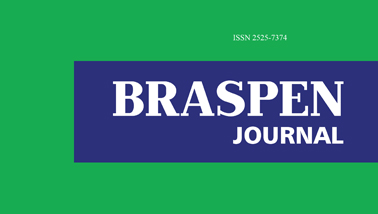Classificação de indicadores de qualidade em ouro e prata por cenário clínico do serviço público de acordo com especialistas em terapia nutricional
Classification of gold and silver quality indicators by clinical setting of the public service according to specialists in nutrition therapy
Lílian Sousa Santana, Guilherme Duprat Ceniccola
Resumo
Introdução: A introdução de práticas de qualidade padronizadas é emergente na terapia nutricional hospitalar. O investimento no controle de qualidade promove redução de custos e melhoria no tratamento, impactando positivamente no processo de recuperação. Poucos são os relatos de estudos que visam apresentar indicadores de qualidade da terapia nutricional (IQTN) confiáveis para o ambiente hospitalar. O objetivo deste trabalho foi selecionar, por meio de um painel de especialistas, IQTN aplicáveis à realidade do setor público brasileiro divididos por cenário clínico. Método: Pela técnica Delphi foi feito um painel de especialistas em duas etapas com questionários eletrônicos. Cada uma dessas etapas foi precedida de um estudo piloto que as simulou identicamente. Entre a primeira e a segunda etapa foi fornecido um feedback de resultados aos participantes, a fim de promover consenso entre os especialistas. Completaram a pesquisa 35 especialistas, que selecionaram indicadores com aceitação entre 80% e 100% divididos em Ouro (≥ 90%), Prata (89% - 80%). Resultados: Foram selecionados 8 indicadores ouro para unidade de terapia intensiva (UTI) e 10 para enfermaria, 8 indicadores prata para UTI e 10 para enfermaria, e nenhum para pronto-socorro. Conclusão: A lista produzida nesse painel forneceI QTN para cenários clínicos específicos, podendo ser utilizada para compor o leque de possibilidades de escolha dessas ferramentas no serviço público hospitalar brasileiro.
Palavras-chave
Abstract
Introduction: The introduction of standardized quality practices is emerging in nutritional therapy. Organized investment in quality, promotes cost reduction and treatment improvement what impact positively in the recovery process. There are few reports of studies that provides reliable quality indicators for Nutritional Therapy (QINT). The aim of this study is to promote a specialist panel to select applicable IQTN to the public health system according to clinical scenario. Methods: It was performed a two stages panel of experts with Delphitechnic utilizing electronic questionnaires. Each of these steps was preceded by a pilot study that simulated identically the first and the second stages. The total of 35 experts completed the study, they selected indicators between 80% and 100% acceptance to compose the final list of IQTN. The indicators were divided into Gold (≥ 90%) and Silver (89% - 80%). Results: A total of 8 gold indicators were selected to Intensive Care Unit (ICU) and 10 to the ward, 8 silver indicators were selected for the ICU and 10 to the ward, not being selected any for emergency room. Conclusion: This panel provided a list of QINT for specific clinical scenarios what can be useful to compose the range of QINT of choice in the Brazilian public hospital reality
Keywords
Referências
1. Meijers JM, Candel MJ, Schols JM, van Bokhorst-de van der Schueren MA, Halfens RJ. Decreasing trends in malnutrition prevalence rates explained by regular audits and feedback. J Nutr. 2009;139(7):1381-6.
2. Soguel L, Revelly JP, Schaller MD, Longchamp C, Berger MM. Energydeficit and length of hospital stay can be reduced by a two-step quality improvement of nutrition therapy: the intensive care unit dietitian can make the difference. Crit Care Med. 2012;40(2):412-9.
3. Waitzberg DL.Indicadores de qualidade em terapia nutricional: aplicação e resultados. São Paulo: ILSI; 2010.
4. Campbell SM, Braspenning J, Hutchinson A, Marshall M. Research methods used in developing and applying quality indicators in primary care. Qual Saf Health Care. 2002;11(4):358-64.
5. Verotti CCG, Ceniccola D, Rajendram R. Top ten quality indicators for the nutritional therapy. In: Rajendram R, Preedy VR, Patel V,eds. Diet and nutrition in the critical care. New York: Springer; 2015. p. 417-28.
6. Alexandre NMC, Coluci MZO. Content validity in the development and adaptation process of measurement instruments.Ciênc Saúde Coletiva. 2011;16(7):3061-8.
7. Rhodes A, Moreno RP, Azoulay E, Capuzzo M, Chiche JD, Eddleston J, et al.; Task Force on Safety and Quality of European Society of Intensive Care Medicine (ESICM). Prospectively defined indicators to improve the safety and quality of care for critically ill patients: a report from the Task Force on Safety and Quality of the European Society of Intensive Care Medicine (ESICM). Intensive Care Med. 2012;38(4):598-605.
8. Pasquali L. Testes referentes ao construto: teoria e modelo da construção. In: Pasquali L, ed. Instrumentos psicológicos: manual prático de elaboração. Brasília: LabPAM/IBAPP; 1999.
9. Brasil. Ministério da Saúde. Resolução da Diretoria Colegiada – RDC,63, de 6 de julho de 2000. Aprova o Regulamento Técnico sobre os requisitos mínimos exigidos para a Terapia de Nutrição Enteral. Brasília: Ministério da Saúde;2000.
10. Carvalho MLR, Morais TB, Amaral DF, Sigulem DM. Hazard analysis and critical control point system approach in the evaluation of environmental and procedural sources of contamination of enteral feedings in three hospitals. JPEN J Parenter Enteral Nutr. 2000;24(5):296-303.
11. Faisy C, Lerolle N, Dachraoui F, Savard JF, Abboud I, Tadie JM, et al. Impact of energy deficit calculated by a predictive method on outcome in medical patients requiring prolonged acute mechanical ventilation. Br J Nutr. 2009;101(7):1079-87.
12. Powell-Tuck J, Gosling P, Lobo DN, Allison SP, Carlson GL, Gore M, et al. British Consensus Guidelines on Intravenous Fluid Therapy for Adult Surgical Patients. (GIFTASUP). London: NHS National Library of Health; 20011. [acesso 2014 Set 22]. Disponível em:http://www.bapen.org.uk/pdfs/bapen_pubs/ giftasup.pdf
13. Casaer MP, Van den Berghe G. Nutrition in the acute phase of critical illness. N Engl J Med. 2014;370(13):1227-36.
14. Sorensen J, Kondrup J, Prokopowicz J, Schiesser M, Krähenbühl L, Meier R, et. al.; EuroOOPS study group. EuroOOPS: an international, multicentre study to implement nutritional risk screening and evaluate clinical outcome. Clin Nutr. 2008;27(3):340-9.
Submetido em:
11/07/2017
Aceito em:
02/10/2017

